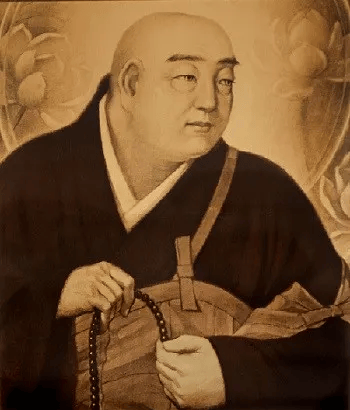

Hōnen (1133-1212) is the founder of Jōdo-shū 浄土宗, the Japanese Pure Land sects. Hōnen entered the priesthood as a child after his father was killed in a political assassination. The story goes that as he lay dying, he urged his son not to avenge his death but to become a monk and seek liberation from the cycle of birth and death.
As a student monk Hōnen was serious and diligent. He spent eleven years on Mt. Hiei studying Tendai Buddhism, which by this time had developed into a complex system of thought and practice. It had also developed into a thoroughly bureaucratic organization with monks vying for position and even political influence.
In 1156, at the age of twenty-four, Hōnen went to Nara to investigate the older forms of Buddhism such as Kegon, Sanron and Hossō. But in none of these forms of Buddhism could he find the peace of mind that he sought. Returning to Mt. Hiei, Hōnen entered into the sutra storehouse at Kurodani and began an intense reading of the entire Buddhist canon.
He ended up reading it three times. The Commentary on the Contemplation Sutra by the seventh century Chinese monk Shan-tao, (善導 Jpn. Zendō), he read over and over until at one point, going over one particular passage, he experienced a type of religious awakening rooted in Shan-tao’s understanding of the human predicament and its relation to the enlightenment of the Buddha of Infinite Life.
That relation was manifest in the practice of nembutsu. The passage was the following: “Single-mindedly and exclusively hold in mind the name of Amida, whether walking, resting, sitting, or lying down, without regard for the length of time, not letting go, thought by thought. This is called the rightly determined karmic act – for it is in accord with that Buddha’s vow". It was surely the final phrase – “for it is in accord with that Buddha’s vow” – that acted as the catalyst for Hōnen’s awakening. At that moment his mind was at rest. All struggling for him ceased, and from then on he spent his time teaching others the path of “sole reliance on the nembutsu.” This was, in a way, the birth of what is now known as Kamakura Buddhism, which took expression in the Pure Land sects, in Zen Buddhism, and in the unique Buddhism of Nichiren.
Hōnen had many disciples, men and women, monks and lay people – in the practice of nembutsu all were equal. However, among the monks who were his followers there were at least six from whom distinct streams of Pure Land Buddhism emerged. To this day three of those traditions survive. Shōkū 証空 (1177-1247) became a disciple in 1190 at the age of fourteen, and is now regarded as the founder of the Seizan school of Jōdo-shū 西山浄土宗. Shōkō 聖光 (1162-1238) began his studies with Hōnen in 1197 at the age of thirty six, and his teachings gave rise to the Chinzei school 鎮西派 of Jōdo-shū 浄土宗, while Shinran 親鸞 (1173-1263), who became a disciple in 1201 at the age of twenty-nine, developed teachings which gave birth to Jōdoshin-shū 浄土真宗, the largest of all Japanese Buddhist sects.
Hōnen
法然
